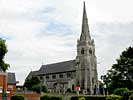 Worksop Worksop
St John
History
The parish of St John’s in Worksop was constituted by order in council in 1867. The church was opened the following year. The venture was conceived in the early 1860s as a way of supplying spiritual provision to the rapidly expanding town of Worksop. The coming of the railway in 1849 and the sinking of the Shireoaks Pit in 1861 had caused a boom in population. As a result, a new church was provided to support the needs of the local community on the north side of the river Ryton where the population was already over 2,000.
It is built in the Early English style consisting of nave with clerestory, aisles, north porch and an embattled western tower 150 feet high containing a clock and two bells. The architect was Messrs. Clarke of Nottingham. The church was built by Charles Wright of Nottingham. Elaborate carving, both interior and exterior, was completed by Messrs. W. P. Smith and sons of Nottingham.
The register dates from 1868.
The foundation stone was laid in 1867 by Viscountess Milton who had given the site. It was placed at the base of the tower on the south side and bears no inscription bar the date given in gothic lettering.
Joseph Garside and G. S. Foljambe contributed £1,000 towards the cost of the building with Foljambe also donating £3,000 to the endowment of the living. The rest of the funds were raised by public subscription. On the day of the stone-laying ceremony, subscribers and friends were invited to meet the building committee at the Corn Exchange in Worksop and process to the building site.
The church was consecrated on 9 August 1869. The service was led by the Bishop of Lincoln. The crowds were so full that admission was only obtained with a ticket from the churchwardens. Local gentry attended the service alongside G. S. Foljambe, Lady Milton, and F. S. Foljambe MP.
In March 1877 there was a dispute between the vicar of St John’s George Dobree and his curate E. T. Hamel. Hamel had preached on Low Sunday a creed that was ‘generally supposed to be characteristic of the Broach Church Party’. The congregation were surprised to find that the vicar, Dobree, publicly refuted the words of his curate and interrupted his preaching. The action contravened canon law. The vicar was thus condemned by the Bishop of Lincoln but retained his position. The curate, Hamel, was advised ‘not to resume his labours in the parish’.
A fire struck the church in January 1878. Luckily, the organist, Mr Walker, found the fire by chance early one evening finding a mass of coals aflame next to the building’s heating apparatus. According to a later report, it was noted that the brickwork above the heating apparatus was cracked and that the fire from the stove passing along this crack had ignited the coals.
Further misfortune came later in 1878 as the church was broken into by thieves. The north door was prized open with ‘great violence’ and the contents of three of the six collection boxes containing alms for the poor stolen. In January 1899 there was another break-in when three poor boxes were raided and the organ badly damaged.
In 1911, the church was rated at a net annual value of £272. The vicar was J. H. Bligh. The population of the parish was 9,343 and the church could accommodate 580. There were 903 on roll for the church day school and 508 for the Sunday school. In the year ending 30 September 1912 there were 252 baptisms and 36 confirmations.
In 1914 the choir vestry was enlarged by an extension to the east side of the building. The Archdeacon of Newark dedicated the new build on 24 May alongside the installation of reading desks, choir stalls, a new chancel floor and communion rails. In 1916 new church yard gates made of oak were installed at a cost of £10 8s 10d.
In 1919 a celebration was had to mark the end of the First World War and the jubilee of the consecration of the church. The organ was rebuilt and remodelled and a brass tablet inscribed with the names of parishioners who had died in the war placed on the north wall. Electric light was also introduced this year and the interior of the spire restored.
The original patrons, the Foljambe family, shared close links with the Church Pastoral Aid Society and transferred patronage to them on 3 August 1922. The church as it stands today still supports CPAS and received help from them in the form of training and advice.
In 1925 the Ecclesiastical Insurance Office paid £32 to cover the costs of repair to the spire following damage by lightning.
A new children’s corner was placed at the east end of the north aisle. A wood-block floor was laid in 1936. In 1940 the children’s corner was removed and renamed ‘Missionary Corner’ in order to free up the space to serve as a side chapel.
In the late 1970s St John’s began pursuing the possibility for extending spiritual provision in the area by building a church in the north end of the parish. A plot of land was purchased and in the 1980s and 1990s the church or St John’s contributed their time and money toward the building of a new centre of worship, Christ Church, which opened in 1993. This second church supported half of the congregation from St John’s and became a separate parish in 2006.
| 




